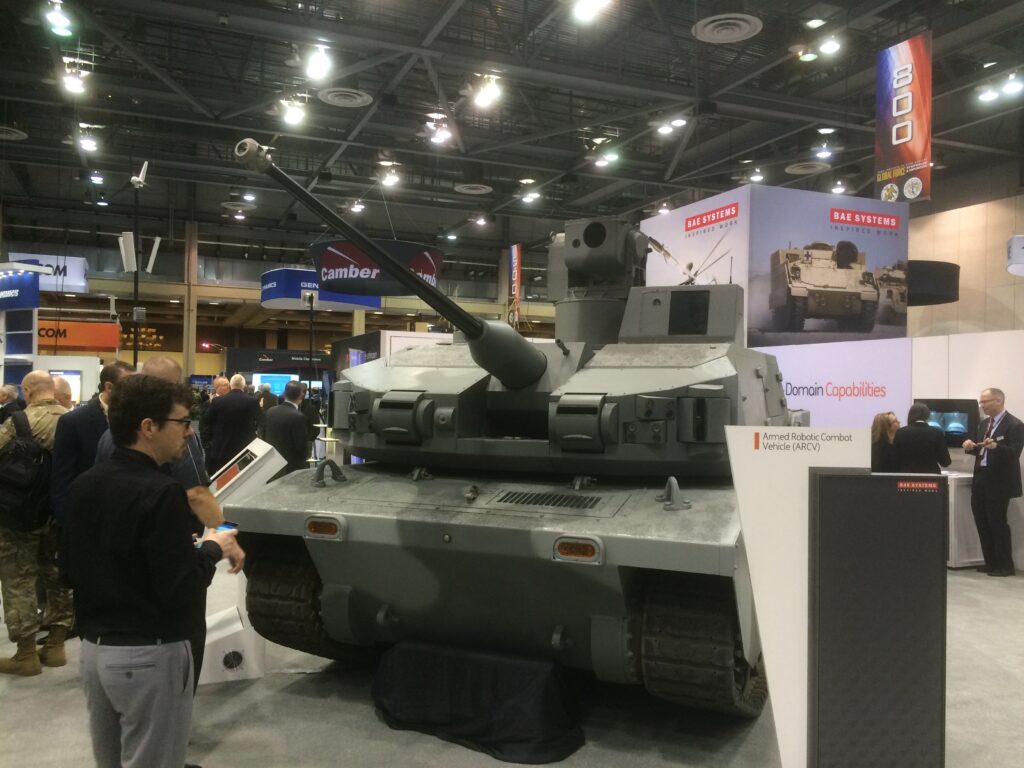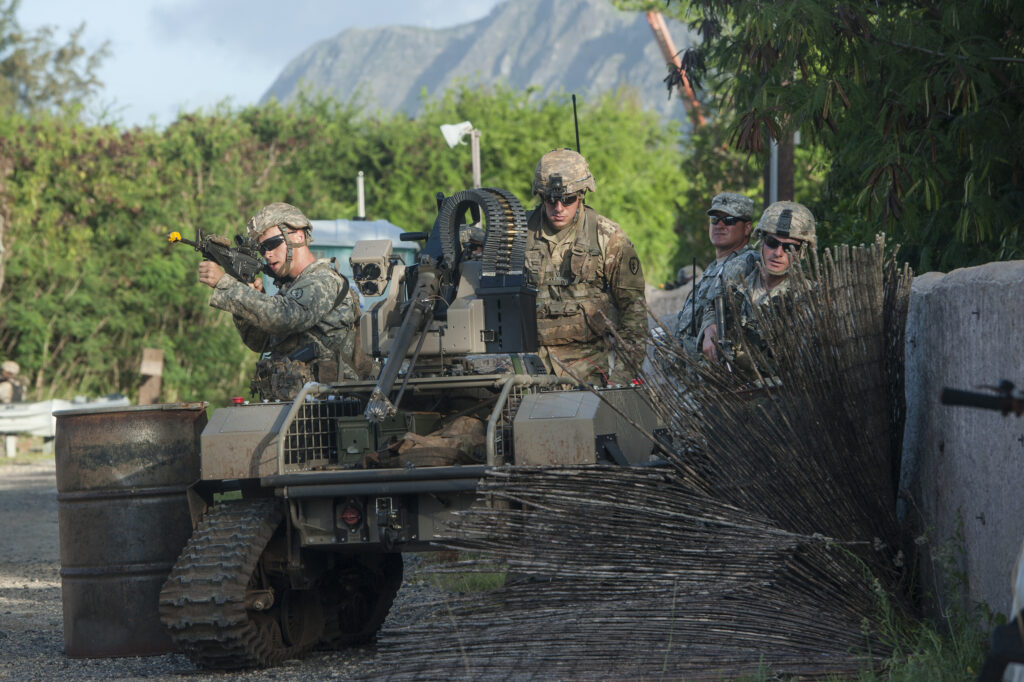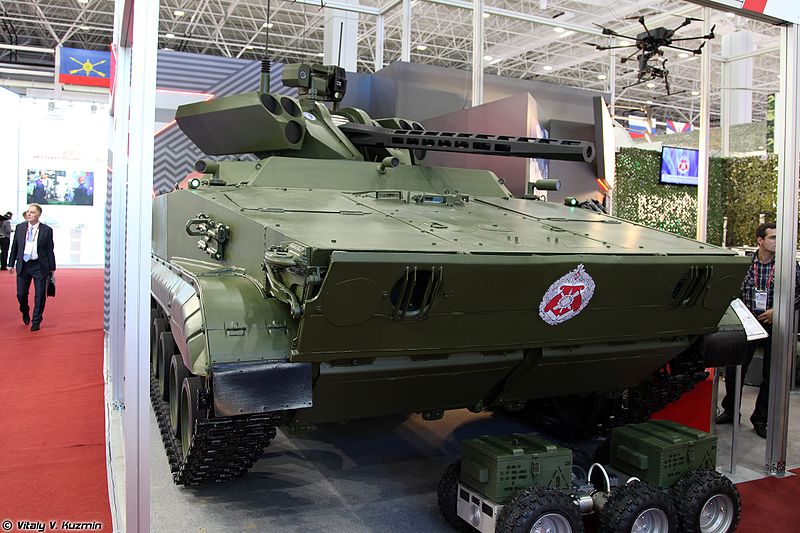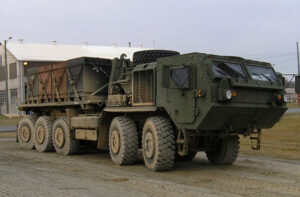 What mission does the Army really need armed robots for -- expendable scouts, perhaps, or supplementary fire support? And does buying robots for that role really offer more tactical value than spending the same money on mundane upgrades to, say, self-propelled artillery? BAE’s Armed Robotic Combat Vehicle (ARCV), originally developed for the Future Combat Systems (FCS) program, a potential model for the Army’s new initiative. Can the Army develop a Robotic Combat Vehicle within six years? Some of the experts we spoke to were deeply skeptical, including veteran congressional staffers badly burned by past acquisition disasters. Some, however, said the Army’s goal was achievable — but the early models will require a lot of human oversight, especially when it’s time to pull the trigger.
What mission does the Army really need armed robots for -- expendable scouts, perhaps, or supplementary fire support? And does buying robots for that role really offer more tactical value than spending the same money on mundane upgrades to, say, self-propelled artillery? BAE’s Armed Robotic Combat Vehicle (ARCV), originally developed for the Future Combat Systems (FCS) program, a potential model for the Army’s new initiative. Can the Army develop a Robotic Combat Vehicle within six years? Some of the experts we spoke to were deeply skeptical, including veteran congressional staffers badly burned by past acquisition disasters. Some, however, said the Army’s goal was achievable — but the early models will require a lot of human oversight, especially when it’s time to pull the trigger.
The Army has radically accelerated its modernization plans overall, which several of our sources said was long overdue, even if they criticized specifics. But fielding a fighting robot is probably the most ambitious of the Army’s new objectives — which is saying something.

A soldier mans a robot-carried machinegun during the Army’s PACMAN-I experiment in Hawaii.
Three Rounds
Last week, the head of the Army’s Cross Functional Team for ground combat vehicles, Brig. Gen. David Lesperance, told reporters he wanted a prototype Robotic Combat Vehicle next year, in 2019. This week, at the AUSA Global Force Symposiumin Huntsville, Ala., Lesperance and other Army officials provided a lot more detail on the timeline. That 2019 delivery just kicks off the first of three rounds of prototyping, each a bit less than two years long, each using feedback from field-tests with Army soldiers to refine the designs:
Phase I – 2019-2020: The first round builds on an Advanced Technology Demonstration (ATD) that was underway before Lesperance’s CFT was formed, the general said at AUSA. The Army has already awarded six contracts for design concepts, which Chief of Staff Mark Milley will personally review, and will soon pick which to actually build. The winners must deliver two prototype Next Generation Combat Vehicles and four Robotic Combat Vehicles by the last quarter of fiscal year 2019. After Army Test & Evaluation Command (ATEC) certifies the vehicles as safe, they’ll be given to an operational unit — combat troops, not professional testers — in the first quarter of fiscal 2020 (i.e. October-December 2019) for six to nine months of trials, including field maneuvers and live fire events. The goal is to establish a baseline level of autonomy for the succeeding phases.
Phase II – 2021-2022: Five teams will each produce three design concepts: one based on workshops with soldiers, one on the latest Research, Development, & Engineering Command (RDECOM) technology, and one the contractor’s choice. The winners will again deliver two manned and four unmanned vehicles, but this time manned and unmanned vehicles must work together as a platoon. (This is called Manned-Unmanned Teaming or, more poetically, a centaur approach). ATEC testing in the third quarter of 2021 will lead to soldier trials in 2021-2022.
Phase III – 2023-2024: This round requires many more vehicles — seven manned and 14 unmanned, operating as a company. The prototypes will be due in the first quarter of 2023 and trials will last until 2024, potentially including “more rigorous, realistic” exercises at a Combat Training Center.
While the structure of the competitions is not yet clear, the Army will allow companies that didn’t win a design contract in one stage to offer entries in the late stages — they’ll just have to do the design work at their own expense.
Lesperance also made clear this timeline is tentative. But he wasn’t suggesting it would slip: Instead, he said it might accelerate.
“We could learn after the end of Phase 2 that, ‘hey we know exactly what we want,'” he told reporters. “The leadership of the Army could look at what we have in Phase I and say, ‘you know what, we like exactly what we’re seeing.'” That said, the earliest he would expect the Army to formally launch a procurement program — what’s called a Materiel Development Decision (MDD) — would be in 2022, and more likely in 2024 after Phase III is complete.
Brig. Gen. David Lesperance
One aspect of this timeline that reassured even the skeptics at least somewhat: It’s all prototyping. The Army is not committing itself to buy robots in bulk, not yet. That’s a stark contrast to the infamous Future Combat Systems, which staked the entire Army modernization effort — eight manned vehicles, air and ground robots, and a network — on unproven technologies being ready on time. If Robotic Combat Vehicles don’t work out, the Army can prototype some more or just give up without cancelling a procurement contract.
In fact, if RCV fails, it won’t affect the rest of the Army’s Big Six modernization efforts, including Lesperance’s other project, the optionally manned Next Generation Combat Vehicle: “Those two lines of effort are not inextricably linked,” he told reporters.
Nevertheless, some critics told us (on background) that they detected a distinct whiff of FCS. There’s the same desire for smaller, lighter combat vehicles, although FCS’s were mostly manned and RCV is not, which makes it easier to reduce armor protection without risking human life.
There’s the same desire to go beyond the cutting edge. True, robotics have advanced a lot since FCS was cancelled in 2009, but self-driving cars still kill peopleon peaceful streets, and battlefields are much harder to navigate.
Finally, there’s the same excitement about technology coupled with a vagueness about tactics. What mission does the Army really need armed robots for — expendable scouts, perhaps, or supplementary fire support? And does buying robots for that role really offer more tactical value than spending the same money on mundane upgrades to, say, self-propelled artillery?
Field-testing the prototypes will hopefully work out both the technical and tactical questions. But what can we realistically expect to emerge?

Russian Vikhr (Whirlwind) unmanned ground vehicle, a modified BMP-3 infantry fighting vehicle.
State of the Art
We can start by looking at the Russians, who’ve invested in a wide range of unmanned ground vehicles (UGVs), some far bigger and better armed than any Western equivalent. “They are currently focused on developing a range of prototypes, from the smallest tracked and wheeled logistics and ISR (intelligence, surveillance, & reconnaissance) robots to the tank-sized Vihr and Uran-9 armored UGVs,” said Samuel Bendett, a CNA scholar who studies the Russian efforts closely. “Despite the American lead in various high-tech technologies and years of prior UGV application, both nations seem to be neck-and-neck conceptualizing and testing these robotic systems.”
Some of the Russian robots, like those used by US bomb squads both at home and in Iraq, are purely remote-controlled, with no artificial intelligence at all: Every slight movement is the direct result of a human entering a command. But some of them are more sophisticated. Aiming and firing weapons would still require direct human input, Bendett told me, but the latest Russian robots are increasingly capable of navigating to the next waypoint designated by their human controller, finding their own path without a human having to drive them every second.
Russian Uran-9 armed unmanned ground vehicle
 “You don’t want to be remotely driving the vehicle,” agreed Paul Scharre, chief military futurist at the Center for a New American security. It’s hard enough to remotely fly a drone like Predator through the empty air: Navigating over ground is harder. Worse, if the controller is also in a moving vehicle — since static control centers would be easy targets — the discrepancy between the bouncing of the vehicle you’re in and the bouncing of the vehicle on your screen causes nausea in about 30 minutes.
“You don’t want to be remotely driving the vehicle,” agreed Paul Scharre, chief military futurist at the Center for a New American security. It’s hard enough to remotely fly a drone like Predator through the empty air: Navigating over ground is harder. Worse, if the controller is also in a moving vehicle — since static control centers would be easy targets — the discrepancy between the bouncing of the vehicle you’re in and the bouncing of the vehicle on your screen causes nausea in about 30 minutes.
But with current technology, Scharre said, we could build robots that drive themselves, either following a manned vehicle in convoy, or following a series of human-specified waypoints. Certainly, some of these robots would get stuck, lost, or into accidents, he said, but so do humans — especially 18-year-old privates who’ve been up for days without sleep, as is all too common in combat.
We don’t have the technology to make a perfect robot that never wrecks itself, Scharre argued, so let’s make cheap robots we can afford to lose. For the United States in particular, which has long invested heavily in a small number of “exquisite” vehicles to prevent casualties, having a large number of expendable robots would revolutionize tactics. US commanders could send robots on high-risk reconnaissance missions, sacrificial feints, or suicidal (non-human) wave attacks.
There’s a lot robots can do with direct human intervention, agreed Thomas Spoehr, a retired three-star general now at the Heritage Foundation. “We can navigate, we can avoid obstacles, we can get to a known point,” he told me. Object recognition software can’t tell a terrorist from a civilian, but it should be able to distinguish friendly vehicles from enemy ones — say, an M-1 from a T-90.
That said, Spoehr went on, you’re still going to need a human deciding whether or not to open fire, which means the robot has to be able to send back live video, which in turn requires a high-bandwidth network. Given Russian expertise at detecting and jamming transmissions, he said, we may have to keep our robots close — within sight — so we don’t lose the connection.
So what does the Army expect its robots to do?
The Army is installing limited autonomy on PLS trucks to allow them to follow along in a convoy without a human driver.
 “The Army’s been researching and developing autonomous behaviors for quite some time now,” said Paul Rogers, directly of the Army’s Tank-Automotive Research, Development, & Engineering Center (TARDEC). While the private sector’s invested vastly larger amounts in self-driving cars, the Army has done extensive work on tactical maneuvers and has “a whole library of behaviors” which contractors should use rather than reinvent, he told the AUSA conference.
“The Army’s been researching and developing autonomous behaviors for quite some time now,” said Paul Rogers, directly of the Army’s Tank-Automotive Research, Development, & Engineering Center (TARDEC). While the private sector’s invested vastly larger amounts in self-driving cars, the Army has done extensive work on tactical maneuvers and has “a whole library of behaviors” which contractors should use rather than reinvent, he told the AUSA conference.
The Army’s already experimented with remote-controlled M113s with machineguns and an M2 Bradley that can drive itself short distances, Rogers said. Next year, it will field robotic trucks that can autonomously follow along in a convoy (the leader vehicle needs to be manned). But that’s a long way from maneuvering in battle.
“It’s going to take a while for those autonomous behaviors to evolve,” said Col. James Schirmer, the Army’s program manager for armored fighting vehicles. “How quickly they’re going to evolve is anyone’s guess.” For the first prototype Robotic Combat Vehicles, he said, he expects them to be completely teleoperated. In other words, there’ll be a human driver and a human gunner controlling everything the RCV does, but they won’t be in it, they’ll be operating it by remote control from another vehicle — which will require uninterrupted high-definition video.
As autonomy improves, however, he expects the robots to get better at navigation and target recognition, reducing both the bandwidth required and the amount of human supervision. From two humans remotely operating one robotic vehicle, he expects to get down to one human operating one RCV, and ultimately to one human overseeing multiple RCVs at once.
No comments:
Post a Comment